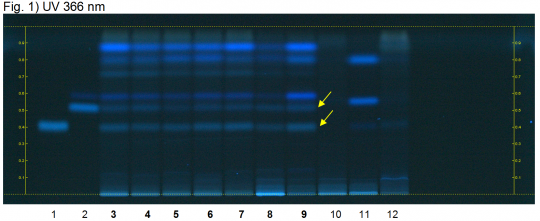Saposhnikovia divaricata (root)
Contents |
Nomenclature
Saposhnikovia divaricata (Turcz.) Schischk. Apiaceae
Syn. Ledebouriella divaricata (Turcz.) Hiroe; Ledebouriella seseloides (Hoffm.) Wolff; Siler divaricatum (Turcz.) Benth. & Hook. f.
Standardized common name (English): siler
Pinyin name(s): fang feng (root)
Botanical Voucher Specimen
Organoleptic Characteristics
Macroscopic Characteristics
Microscopic Characteristics
High Performance Thin Layer Chromatographic Identification
|
Saposhnikovia root, Fang feng (root) (Saposhnikovia divaricata) Lane Assignments Lanes, from left to right (Track, Volume, Sample):
Reference Sample(s) Reference: Dissolve 1.0 mg of Prim-O-glucosylcimifugin in 1 mL of methanol. Dissolve 1.0mg of 4'-O-β-D-Glucosyl-5-O- methylvisamminol acid in 1 mL of methanol. Stationary Phase Stationary phase, i.e. Silica gel 60, F254 Mobile Phase Dichloromethane, methanol, acetonitrile 4:2:1 (v/v/v) Sample Preparation Method Sample: Mix 1.0 g of powdered sample with 10 mL of methanol and sonicate for 30 minutes, then centrifuge or filter the solutions and use the supernatant / filtrate as test solution. Detection Method Saturated chamber; developing distance 70 mm from lower edge; relative humidity 33% Other Notes Images presented in this entry are examples and are not intended to be used as basis for setting specifications for quality control purposes. System suitability test: Prim-O-glucosylcimifugin: fluorescent zone at Rf ~ 0.41; 4'-O-β-D-Glucosyl-5-O-methylvisamminol: fluorescent zone at Rf ~ 0.51. Identification: Compare result with reference images. The fingerprint of the test solution is similar to that of the corresponding botanical reference sample. Additional weak zones may be present. The chromatogram of the test solution shows blue fluorescent zones at Rf ~ 0.41 and Rf ~ 0.51 corresponding to reference substances prim-O-glucosylcimifugin and 4'-O-β-D-Glucosyl-5-O-methylvisamminol (yellow arrows). Several blue fluorescent zones are detected above the position of reference substance 4'-O-β-D-Glucosyl-5-O-methylvisamminol. Test for adulteration: Caraway root, Wild Carrot root and Seseli mairei root show no blue zone at the position of reference substances prim-O-glucosylcimifugin and 4'-O-β-D-Glucosyl-5-O-methylvisamminol.
|
Supplementary Information
Sources
- ↑ HPTLC Association http://www.hptlc-association.org/
